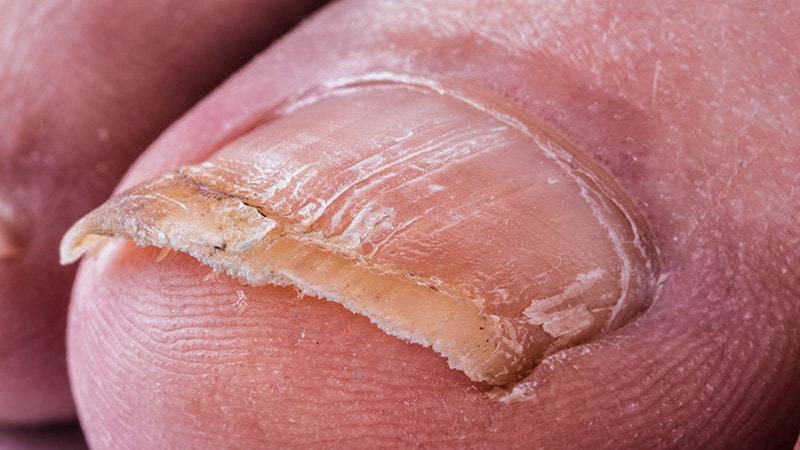Factors Associated with Onychomycosis in Patients with Onychodystrophy: A Retrospective Case-Control Study
Kernkonzepte
Patients with onychodystrophy who have a history of tinea pedis, chronic kidney disease, peripheral vascular disease, or type 2 diabetes are at an increased risk of having onychomycosis.
Zusammenfassung
This retrospective case-control study aimed to identify factors associated with histopathologically confirmed onychomycosis in patients with onychodystrophy. The researchers evaluated data on 1256 patients with onychodystrophy seen at Weill Cornell Medicine from January 2013 to October 2020.
Key findings:
Overall, 47% of patients had onychomycosis.
Tinea pedis (odds ratio [OR], 10.3), chronic kidney disease (OR, 2.3), peripheral vascular disease (OR, 2.1), and type 2 diabetes (OR, 1.6) were associated with a significantly increased risk for onychomycosis.
Tinea pedis (OR, 11.4) and peripheral vascular disease (OR, 1.9) were positive predictors of onychomycosis.
A history of psoriasis (OR, 0.4) and female sex (OR, 0.6) were negative predictors of onychomycosis.
The authors suggest that these findings argue against empiric treatment and may help dermatologists identify patients more likely to have onychomycosis, encouraging appropriate testing and antifungal stewardship.
Study Identifies Several Onychomycosis Risk Factors
Statistiken
Patients with onychodystrophy who have a history of tinea pedis have a 10.3-fold increased risk of having onychomycosis.
Patients with onychodystrophy who have chronic kidney disease have a 2.3-fold increased risk of having onychomycosis.
Patients with onychodystrophy who have peripheral vascular disease have a 2.1-fold increased risk of having onychomycosis.
Patients with onychodystrophy who have type 2 diabetes have a 1.6-fold increased risk of having onychomycosis.
Patients with onychodystrophy who have a history of psoriasis have a 0.4-fold (or 60% lower) risk of having onychomycosis.
Patients with onychodystrophy who are female have a 0.6-fold (or 40% lower) risk of having onychomycosis.
Zitate
"The results 'argue against empiric treatment, as visual examination and patient-level factors may not reliably indicate onychomycosis,' the authors wrote, 'and may help dermatologists identify patients more likely to have onychomycosis, encouraging appropriate testing and antifungal stewardship.'"
Wichtige Erkenntnisse aus
by Manasi um www.medscape.com 05-19-2024
https://www.medscape.com/viewarticle/study-identifies-onychomycosis-risk-factors-patients-2024a10009h7
Tiefere Fragen
How do the identified risk factors for onychomycosis in onychodystrophy patients compare to the general population?
The identified risk factors for onychomycosis in onychodystrophy patients, such as a history of tinea pedis, chronic kidney disease, peripheral vascular disease, and type 2 diabetes, show a significant difference compared to the general population. These factors are associated with an increased risk of onychomycosis in patients with onychodystrophy, indicating a specific susceptibility profile that differs from the broader population. This suggests that individuals with onychodystrophy and these comorbidities should be closely monitored for the development of onychomycosis due to their heightened risk.
What are the potential underlying mechanisms linking the observed risk factors to the development of onychomycosis?
The potential underlying mechanisms linking the observed risk factors to the development of onychomycosis in patients with onychodystrophy can be multifaceted. For instance, tinea pedis, a common fungal infection of the feet, can serve as a reservoir for the fungi that cause onychomycosis, facilitating its spread to the nails. Chronic kidney disease and peripheral vascular disease may compromise the immune system, making individuals more susceptible to fungal infections like onychomycosis. Type 2 diabetes, with its associated vascular and immune system impairments, can create an environment conducive to fungal growth. These conditions collectively create an environment that promotes the development and persistence of onychomycosis in patients with onychodystrophy.
What are the implications of this study for the management and prevention of onychomycosis in patients with onychodystrophy?
This study has significant implications for the management and prevention of onychomycosis in patients with onychodystrophy. Firstly, it highlights the importance of accurate diagnosis in this population, especially considering the increasing antifungal resistance. Healthcare providers should be vigilant in assessing patients with onychodystrophy for the identified risk factors, such as tinea pedis, chronic kidney disease, peripheral vascular disease, and type 2 diabetes, to promptly diagnose and treat onychomycosis. Additionally, the study emphasizes the need for targeted interventions and antifungal stewardship in high-risk individuals to prevent the development and recurrence of onychomycosis. By identifying and addressing these risk factors early, healthcare professionals can improve the management outcomes and quality of life for patients with onychodystrophy at risk for onychomycosis.
0
